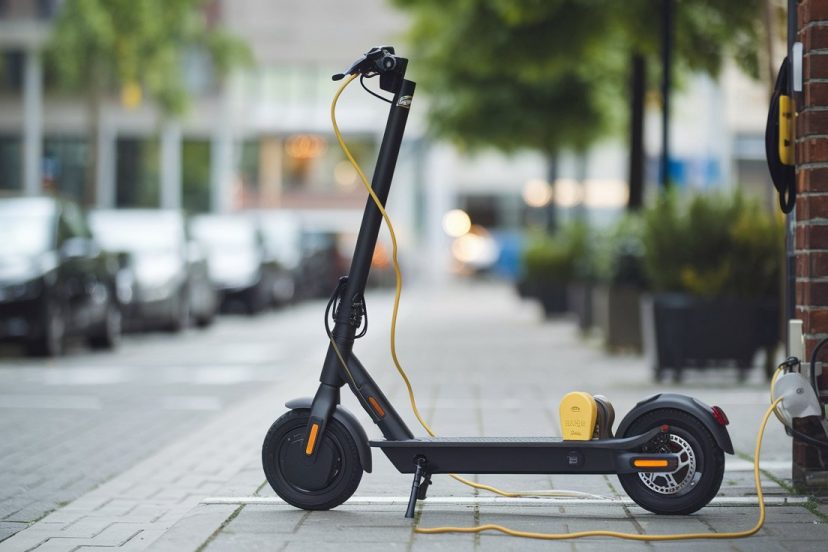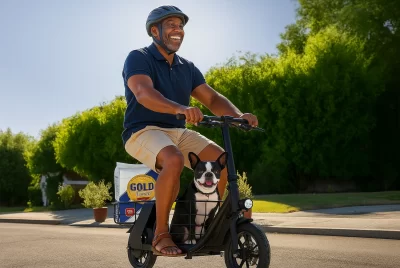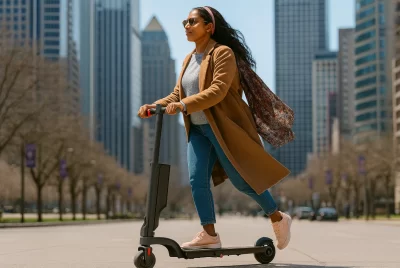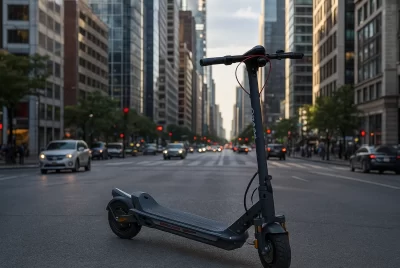Electric Scooter Charging Best Practices
*We may earn a commission for purchases made using our links. Please see our disclosure to learn more.
Electric scooters serve as popular transportation choice because they provide convenience while being environmentally friendly and delivering enjoyable riding experiences. The battery health depends on proper maintenance because it determines both the longevity and operational performance of your electric scooter.
I have personal experience showing that scooter charging best practices significantly affect performance. Basic habits which include proper care will extend battery life while avoiding problems and maintaining your scooter’s operational efficiency. Many scooter riders fail to worry about battery maintenance until their scooter develops issues.
This guide provides you with the most effective methods to properly charge your electric scooter. These guidelines will maximize your ride experience by explaining both incorrect charging methods and optimal charging procedures. Electric scooter owners who maintain their battery properly will avoid future expenses and maintenance issues. Let’s dive in!
Key Takeaways
- Charge your scooter properly to extend battery life.
- Avoid overcharging or draining the battery completely.
- Use the correct charger and charge in a suitable environment.
- Store your scooter with a partially charged battery if not in use for a long time.
- Follow manufacturer guidelines for best results.
Understanding Your Electric Scooter Battery
The majority of electric scooters operate using lithium-ion (Li-ion) batteries which provide both efficiency and compact power storage along with lightweight construction. The batteries provide excellent performance and portability characteristics which make them suitable for personal electric vehicles. The rechargeable nature of these batteries comes with a defined lifespan because improper maintenance will cause their degradation.
Proper maintenance of your battery allows your scooter to operate efficiently throughout multiple years but improper charging best practices result in reduced range and performance and eventually force you to replace it at a high cost. Knowledge of your battery operation combined with intelligent charging techniques will optimize your scooter’s performance.
Why Battery Care Matters
Taking proper care of your electric scooter’s battery isn’t just about keeping it charged, it’s about ensuring long-term reliability and efficiency. Here’s why good battery maintenance is important:
- Longer Battery Life – Proper charging habits can extend the lifespan of your battery, saving you money on replacements.
- Consistent Performance – A well-maintained battery ensures your scooter runs smoothly and efficiently.
- Better Range Per Charge – Optimizing charging habits can help your battery hold a charge longer, allowing you to travel farther without frequent recharges.
- Fewer Breakdowns and Repairs – A healthy battery reduces the chances of sudden power loss, preventing inconvenient breakdowns.
Battery Lifespan and Charging Cycles
The lifespan of Lithium-ion batteries has limits but correct maintenance techniques will extend their operational time. The typical lifespan of an electric scooter battery consists of 300 to 500 charge cycles before its capacity significantly decreases. A charge cycle consists of using 100% of the battery capacity through either one complete charge or various smaller charges that sum to one complete cycle.
Following expert guidelines will help you achieve longer battery life than typical cycle ranges by preventing complete discharges. The recommended practice for battery maintenance involves keeping the charge level between 20% and 80% instead of fully draining it before recharging. The practice of charging your battery partially instead of fully reduces its stress which enables it to operate efficiently for longer periods.
The health of your battery depends on three main factors which include extreme temperatures and improper storage and the practice of frequent fast charging. The following sections present the most effective charging best practices together with safety errors to prevent which will maintain your electric scooter battery at its best performance.
Best Practices for Charging Your Electric Scooter
Electric scooter battery performance and lifespan benefits significantly from proper charging best practices. The correct habits lead to maximum efficiency while protecting your scooter from premature wear and extending its operational period. The following methods represent the most effective approach to maintain battery health and extend its operational life.
1. Use the Correct Charger
Always use the charger that came with your scooter or a certified replacement. Using the wrong charger, especially one with incorrect voltage or amperage, can damage the battery, reduce its lifespan, and even pose safety risks like overheating or short circuits.
- If you lose your charger, check your scooter’s voltage and amperage requirements before buying a replacement.
- Look for OEM (Original Equipment Manufacturer) chargers or high-quality third-party brands designed for your scooter model.
2. Charge in a Cool, Dry Place
Temperature and humidity play a huge role in battery health. Extreme heat or cold can degrade battery cells and reduce overall performance. The best environment for charging is room temperature in a dry, well-ventilated area.
- Avoid charging in direct sunlight, extremely hot areas (above 104°F or 40°C), or freezing conditions (below 32°F or 0°C).
- Avoid damp or humid environments to prevent electrical malfunctions.
- Ideal charging conditions are between 50°F and 86°F (10°C to 30°C).
3. Don’t Let Your Battery Fully Deplete
A common misconception is that lithium-ion batteries should be fully drained before recharging. In reality, keeping your battery between 20% and 80% significantly extends its lifespan.
- Fully depleting the battery frequently stresses the cells and reduces long-term capacity.
- While some scooters have built-in battery management systems (BMS) to prevent complete discharge, it’s still best to recharge before reaching low levels.
- Charging when the battery reaches around 30-40% helps maintain battery health.
4. Avoid Overcharging
Leaving your scooter plugged in overnight or for extended periods can overheat the battery, leading to long-term damage. While most modern scooters have overcharge protection, it’s still best to unplug the charger once the battery reaches 100%.
- If you frequently forget to unplug, consider using a timer plug to cut off power after a set period.
- Setting a reminder or alarm can help prevent unnecessary overcharging.
5. Allow the Battery to Cool Before Charging
If you’ve just finished a ride, let the battery cool down for at least 15-30 minutes before plugging it in. Charging a hot battery can cause overheating, reduce efficiency, and lead to long-term damage.
- This is especially important after long rides or riding in hot weather.
- Heat buildup inside the battery can increase the risk of damage or even fire hazards.
6. Store Your Scooter with a Partially Charged Battery
If you won’t be using your scooter for a while, avoid leaving the battery fully charged or completely drained, as both can accelerate battery wear. Instead, store it with a charge level of around 50-60%.
- Store the scooter in a cool, dry place away from direct sunlight.
- Check and recharge the battery every 1-2 months to prevent deep discharge.
- Avoid keeping the scooter plugged in while in storage.
7. Check Battery Health Regularly
Some electric scooters come with companion apps that allow you to monitor battery health, temperature, and overall performance. If your scooter has this feature, check it regularly to catch potential issues early.
- If your battery drains much faster than before, takes longer to charge, or overheats frequently, it may be time for a replacement.
- If you notice any issues, consult your scooter’s manufacturer for troubleshooting steps.
Following these best practices can extend your scooter’s battery life, improve performance, and reduce the likelihood of costly repairs. Proper battery care ensures that your electric scooter remains reliable and efficient for years to come.
Additional Charging Tips for Maximum Efficiency
Using these additional tips along with best practices for charging will maximize your electric scooter battery life while improving operational efficiency and minimizing potential damage. The battery life of your electric scooter together with its reliability depends on proper maintenance combined with careful charging habits.
Charge Your Scooter at the Right Time
When and how you charge your scooter can impact both its performance and your electricity costs.
- Try to charge your scooter at a steady rate instead of frequently plugging and unplugging it throughout the day.
- If possible, avoid charging during peak energy hours, typically in the late afternoon or early evening when electricity demand is highest.
- Many utility companies offer lower rates during off-peak hours (late nights or early mornings), which can save you money over time.
- Charging during cooler hours can also help prevent unnecessary heat buildup, which can degrade battery life.
Invest in a Smart Charger
Standard chargers provide a constant flow of power, but smart chargers optimize the charging process by adjusting voltage and current levels to extend battery life.
- Smart chargers help prevent overcharging by switching to a trickle charge mode once the battery reaches full capacity.
- Some models can diagnose battery health and adjust the charging cycle to match the battery’s condition.
- Investing in a high-quality smart charger can improve efficiency and reduce unnecessary battery strain.
Clean the Charging Port Regularly
Over time, dust, dirt, and moisture can accumulate inside the charging port, leading to poor connections, slower charging speeds, or even damage to the electrical components.
- Use a soft brush, cotton swab, or compressed air to gently clean the charging port.
- Avoid using metal objects or excessive force, as this can bend or damage the charging pins.
- If the port is exposed to water or excessive moisture, let it dry completely before plugging in the charger.
- Regular maintenance ensures a secure connection and helps prevent potential charging issues.
Upgrade to a Higher-Capacity Battery (If Possible)
If your scooter model allows for battery upgrades, switching to a higher-capacity battery can provide several benefits:
- Increases the range per charge, reducing the number of charging cycles needed and prolonging battery life.
- Offers better performance for longer rides without frequent recharges.
- Some upgraded batteries come with advanced thermal management features, improving heat resistance and efficiency.
Before upgrading, check with your scooter’s manufacturer to ensure compatibility and confirm that the new battery meets safety standards.
Conclusion
Electric scooter battery maintenance stands as a critical factor for achieving extended performance alongside efficiency and reliability. A properly cared for battery extends its operational lifespan while delivering better ride quality and decreasing replacement expenses.
Proper charging best practices help extend the lifespan of electric scooter batteries. The best performance results from using the correct charger while avoiding full depletion and preventing overcharging and proper scooter storage. The health of your battery improves substantially when you make small changes to your charging and maintenance routine.
The implementation of basic battery maintenance techniques leads to noticeable performance enhancements according to personal experience. The simple maintenance practices provide users with their best scooter experience regardless of whether they commute daily or ride occasionally.
Frequently Asked Questions
1. Can I charge my electric scooter overnight?
Modern electric scooters often include overcharge protection, but unplugging the charger once the battery reaches full capacity helps prevent heat buildup and maintains efficiency. Leaving it connected for long periods may accelerate battery wear.
2. How often should I charge my electric scooter?
Charging when the battery level drops to around 30 to 40 percent is ideal. Avoid letting it fully deplete because frequent deep discharges shorten battery lifespan. Keeping the battery at full charge for extended periods also affects long-term performance.
3. What should I do if my scooter battery is not charging?
If the battery does not charge, try these troubleshooting steps:
- Ensure the charger is properly connected and test a different power outlet
- Check the charging port for dust or debris that may be blocking the connection
- Try another charger that matches the scooter’s specifications
- Contact the manufacturer or a professional technician if the issue persists
4. Can I use a different charger for my scooter?
Using only the charger provided with the scooter or a certified replacement is important. An incompatible charger with incorrect voltage or amperage can damage the battery and create a fire hazard.
5. How do I store my scooter for winter or long periods?
When storing the scooter for an extended time, follow these steps:
- Keep the battery at 50 to 60 percent charge to prevent deep discharge
- Store the scooter in a cool and dry place away from extreme temperatures
- Recharge the battery every one to two months to maintain its health
- Avoid leaving the scooter plugged in during storage
Following these charging and maintenance practices ensures an electric scooter remains in great condition for years. Taking a little time to care for the battery today guarantees longer and more reliable rides in the future. Enjoy the journey.




